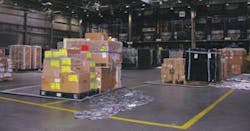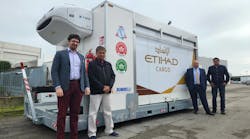Two and a half miles from its expansive Terminal 8 at JFK International Airport, American Airlines has continued its development at the airport — most recently with its cargo division. Cargo handling operations have begun at a new facility — a move it made to promote efficiency in its operations.
And efficiency is imperative for the operation, which serves a large region spanning from Canada to North Carolina, and boasts the largest pounds per departure.
The new facility — located in building 79, which was previously owned by All Nippon Airways — was officially opened for business by American Airlines Cargo in March.
The company moved from a location of 200,000 square feet to a 135,000-square foot building. Though it offers less square footage, Jonathan Jay, managing director – cargo services for American Airlines at JFK, says the new location is more of a fit for its current operation. “Back when that building was built, we needed all that room,” he says.
“Business changes, so we found that we were not using a lot of that building.”
He explains, “When American had freighters that were set up, the old building was set up for 707 freighters — we had big operation going. We don’t have that anymore. We handle more cargo now in lower deck capacity than we ever did. We average between 700,000 and 800,000 pounds a day, just lower deck. That’s pretty good – that’s about three or four 747s a day.”
The facility has the capacity to handle approximately 35 million pounds per month. In addition to extensive racking space, it also features three coolers for temperature-sensitive cargo.
But the main objective of the move was a handling system that would promote more efficient operations overall. “What we wanted was a handling system that would receive the business that we handle,” he says. “Sixty-five percent of our business is customer- loaded containers, so out of 700,000 pounds, that’s a lot. So we need a way to load trucks and unload trucks relatively quickly without forklifts.”
Handling System
The handling system in place at building 79 offered a solution, he says.
The system includes six dock doors, a raceway with the capacity to hold about 30 PMCs, and two elevated transfer vehicles that can facilitate the movement of units at a rate of 60 feet per minute — without the need for forklifts. The system has cut the time it takes to receive cargo by about half, he says.
The handling system has been paired with a wi-fi tracking system installed by AA Cargo. It is also working to launch a new project for location tracking. “The new project is more of a Web-based process, but it will allow us to identify shipments at the piece level,” he says. “Not just containers, but when there is bulk cargo, we’ll be able to tell you exactly which piece is shipped or split.”
It will also allow for cargo to be received by using a hand-held device, he says.
The move and technological developments came at an opportune time, as the company has begun to see some recovery in cargo. “We’ve had a very, very good March — a very good first quarter. In this facility, we were up about 22 percent for the month of March. We handled an additional 4 million pounds.”
Screening Challenge
An industry-wide standard that requires 75 percent of passenger cargo to be screened went into effect May 1, leading up to a 100-percent standard in August. “We do a lot of screening now,” he says. “We’re in the 80-percent range. We’re above the requirement now, and it’s just getting to the 100 percent.”
While the cargo division has plans to invest in equipment to reach the 100-percent screening capability, it will also look to partners in the supply chain to share in the responsibility.
“What we want, to make it good for the shipper and good for us, is to have the shipper do the screening,” he says. “We want everybody to be a certified screener. What happens is when you buy a computer or something like that, if they aren’t certified and it’s not screened when we get it, then we’re going to screen it.”
And the development of the facility is ongoing, in particular the development of an automotive shop to support freight vehicles at the location.
Additional Developments
And American has continued in investing in additional facilities for its ground handling operations at JFK. The airline rebuilt its terminal GSE maintenance shop about three years ago. It is one of two GSE maintenance shops at JFK, with another located at the hangar.
The previous facility was lacking in some needs. “The highest you could lift a tractor up was with a jack and that was it, that was how we worked for years,” says Robert Cobb, customer service manager and ground service equipment maintenance at American Airlines.
The project reflected the airline’s shift to a more rigid maintenance schedule than in years past. “It was more relaxed then because the equipment was newer so it held up,” he says.
Now a more stringent schedule is in place. “Each shift now has people now that are assigned to PMs and PMs only,” he says.
He continues, “Different people are assigned to different things. There is a powered crew and a non-powered crew.”
The maintenance staff has also taken on various projects to maintain its equipment, including a complete refurbishment of 13 container loaders.
American has become more stringent with its maintenance programs to sustain its existing equipment. Its new-equipment purchases have mostly come in the form of electric. In particular, electric tugs and forklifts for a total of about 170 vehicles of its fleet at JFK.
And the company will undoubtedly continue to develop its presence at JFK. Cobb, who has been with American for 43 years at JFK, has seen the changes firsthand. “The expansions we’ve done, it’s unbelievable,” he says.




